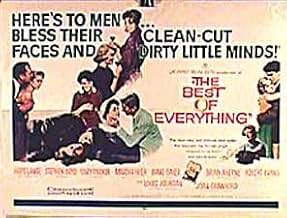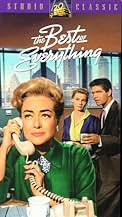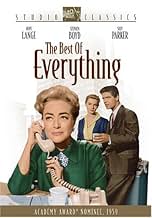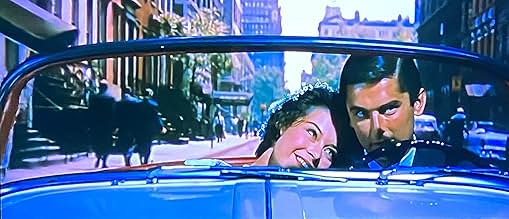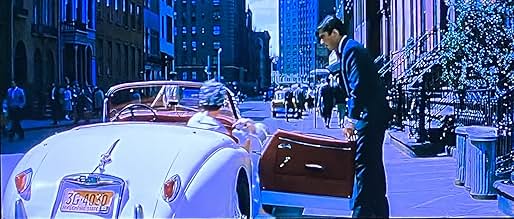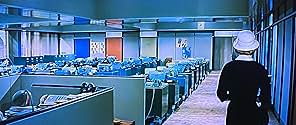NOTE IMDb
6,6/10
2,5 k
MA NOTE
Ajouter une intrigue dans votre langueAn expose of the lives and loves of Madison Avenue working girls and their higher ups.An expose of the lives and loves of Madison Avenue working girls and their higher ups.An expose of the lives and loves of Madison Avenue working girls and their higher ups.
- Réalisation
- Scénario
- Casting principal
- Nommé pour 2 Oscars
- 2 nominations au total
Linda Hutchins
- Jane
- (as Linda Hutchings)
Ted Otis Sr.
- Dr. Ronnie Wood
- (as Ted Otis)
Gertrude Astor
- Leading Woman in Play
- (non crédité)
Alan Austin
- Bill
- (non crédité)
Joseph Bardo
- Policeman
- (non crédité)
Avis à la une
Every few years, Fox would go to a favorite story of theirs - Three girls rooming together, looking for career and romantic success and finding lots of heartache along the way. The first time Fox did this was with the 1936 film "Ladies In Love", set in Budapest. Later incarnations were "How To Marry A Millionaire", "Three Coins in the Fountain", and this film. There may be others of which I am not aware.
In this incarnation, three women trying to break into the publishing business decide to room together in a tiny apartment in Manhattan. Caroline Bender (Hope Lange) is a recent graduate of one of the female Ivys - Radcliffe - and that prime education buys her a ticket into - the stenographic pool??? She has aspirations of being editor, a job currently held by Amanda Farrow (Joan Crawford), but in the words of Highlander, "there can be only one", and she has lots of competition in the steno pool not to mention Farrow likes her view from the throne.
Complications ensue. And those complications include out of wedlock pregnancy, affairs with married men, and various men lecturing women who aspire to be more than stenographers, given their Ivy League educations, about how the road to success will sap their femininity. Note that these lecturing men are NOT having to serve time in the steno pool on their much more abbreviated way to the top!
I can't blame Fox too much for this repetition. WB had a fondness for a few stories that they did retreads of during the production code era too. See the film "Slim" for reference, along with all of its remakes and forerunners.
In this incarnation, three women trying to break into the publishing business decide to room together in a tiny apartment in Manhattan. Caroline Bender (Hope Lange) is a recent graduate of one of the female Ivys - Radcliffe - and that prime education buys her a ticket into - the stenographic pool??? She has aspirations of being editor, a job currently held by Amanda Farrow (Joan Crawford), but in the words of Highlander, "there can be only one", and she has lots of competition in the steno pool not to mention Farrow likes her view from the throne.
Complications ensue. And those complications include out of wedlock pregnancy, affairs with married men, and various men lecturing women who aspire to be more than stenographers, given their Ivy League educations, about how the road to success will sap their femininity. Note that these lecturing men are NOT having to serve time in the steno pool on their much more abbreviated way to the top!
I can't blame Fox too much for this repetition. WB had a fondness for a few stories that they did retreads of during the production code era too. See the film "Slim" for reference, along with all of its remakes and forerunners.
A classic late 50's film. The superannuated headliners (Joan Crawford and Louis Jordan) are not at their best, but the direction, cinematography, and acting of the younger cast are compelling. In a 50's sense (which I love).
The look and feel of the artsy (over-artsy?) contemporary film "Far from heaven" reflects exactly this sort of film (and I suspect this film may be one of the models). A silly plot, of course (hey, it's 1959!), but as a film-- glorious! As a reflection of the society, extremely interesting. And as witness to how Hollywood breaks away from the idealistic portrayal of American sexual mores, fascinating.
The look and feel of the artsy (over-artsy?) contemporary film "Far from heaven" reflects exactly this sort of film (and I suspect this film may be one of the models). A silly plot, of course (hey, it's 1959!), but as a film-- glorious! As a reflection of the society, extremely interesting. And as witness to how Hollywood breaks away from the idealistic portrayal of American sexual mores, fascinating.
Meant to be a glossy romance and cautionary tale for girls who dare to think of working Outside The Home, "The Best of Everything" instead is a virtual primer of the root causes of the modern Women's movement: Women (really, girls) can have jobs, but only until they find a man and leave to begin their real lives as homemakers; women are sexual toys, provided to men at work for their amusement; all men are predators and all women are fools; pregnancy is entirely the woman's fault; women who take their jobs seriously are damaged people; women merely exist for the use of men. Sounds like an unremitting screed, and it is -- yet, such is Hollywood's power, the pageant is very watchable (the clothes, the sentimental views of 1959 NYC) and beautiful. A wonderful snapshot of America just a couple of years before "The Feminine Mystique" was published. Must-see for women.
More equality today, much more, but overall nothing has changed. All the sad, tawdry, pathetic, moving and bitter moments between women and men in the office is just as it is today, less the blatant sexual harassment. Love looking at old pics of nyc and looking in store windows....things seem surprisingly familiar and not dated.
The Best of Everything is a high gloss large screen soap opera which follows the careers of four career women, Hope Lange, Suzy Parker, Diane Baker, and Martha Hyer at a New York publishing firm. What's the best for some women is not necessarily the best for all.
Presiding over this group of young fillies is wise old mare Joan Crawford who's been around the track a few times on screen and in real life. She looks right at home as the boss lady as well she should have at this point.
Around the time she was making The Best of Everything Joan Crawford became a widow when her fourth husband, Alfred Steele died. It was a particularly traumatic event for her, she woke up one morning and found him dead in bed next to her. She inherited all of his stock in Pepsi Cola where he was the board chairman and during the same period as The Best of Everything was being made, she wound up the queen bee at Pepsi Cola. Life does sometimes imitate art. So that authority as she barks out dictation and coffee orders to Hope Lange rings real true.
In fact all the women here with the exception of Lange are in for some rough sledding. It's rough for Lange too, but she literally makes the best of everything.
What a collection of stinkers the men are in this film. The best of them, Stephen Boyd, is a heavy drinker. The others Louis Jourdan, Robert Evans, and Brett Halsey, are as slimy a collection of rodents as ever gathered for one film.
I can't forget Brian Aherne either who's the fanny pinching head of this publishing firm. Half that office would have sexual harassment suits going today.
Some nice location shots of New York in the fifties make the film a real treat. Catch it by all means.
Presiding over this group of young fillies is wise old mare Joan Crawford who's been around the track a few times on screen and in real life. She looks right at home as the boss lady as well she should have at this point.
Around the time she was making The Best of Everything Joan Crawford became a widow when her fourth husband, Alfred Steele died. It was a particularly traumatic event for her, she woke up one morning and found him dead in bed next to her. She inherited all of his stock in Pepsi Cola where he was the board chairman and during the same period as The Best of Everything was being made, she wound up the queen bee at Pepsi Cola. Life does sometimes imitate art. So that authority as she barks out dictation and coffee orders to Hope Lange rings real true.
In fact all the women here with the exception of Lange are in for some rough sledding. It's rough for Lange too, but she literally makes the best of everything.
What a collection of stinkers the men are in this film. The best of them, Stephen Boyd, is a heavy drinker. The others Louis Jourdan, Robert Evans, and Brett Halsey, are as slimy a collection of rodents as ever gathered for one film.
I can't forget Brian Aherne either who's the fanny pinching head of this publishing firm. Half that office would have sexual harassment suits going today.
Some nice location shots of New York in the fifties make the film a real treat. Catch it by all means.
Le saviez-vous
- AnecdotesJoan Crawford, recently elected to the board of directors of Pepsi after the death of her husband who had been President and CEO of the company, managed to swing a brief quasi product plug for the soft drink by having an unmistakable Pepsi machine (with the red, white, and blue Pepsi logo, but sans the word "Pepsi") installed in the secretaries' on-screen break room.
- GaffesIn the scene when Diane Baker tells Hope Lange "he's ten foot tall to me" while walking down the street, several people... two men and two young boys... look into the camera, smiling (they were obviously filming with a camera hidden in a car during these scenes as those people weren't extras).
- Citations
Amanda Farrow: Now you and your rabbit-faced wife can both go to hell!
- ConnexionsFeatured in Playboy's Penthouse: Épisode #1.1 (1959)
- Bandes originalesThe Best of Everything
by Sammy Cahn and Alfred Newman
Johnny Mathis sings during the opening credits
Also sung by a chorus at the end
Played often in the score
Meilleurs choix
Connectez-vous pour évaluer et suivre la liste de favoris afin de recevoir des recommandations personnalisées
- How long is The Best of Everything?Alimenté par Alexa
Détails
- Date de sortie
- Pays d’origine
- Langue
- Aussi connu sous le nom de
- Las audaces
- Lieux de tournage
- Sociétés de production
- Voir plus de crédits d'entreprise sur IMDbPro
Box-office
- Budget
- 2 500 000 $US (estimé)
- Durée2 heures 1 minute
- Couleur
- Rapport de forme
- 2.35 : 1
Contribuer à cette page
Suggérer une modification ou ajouter du contenu manquant

Lacune principale
By what name was Rien n'est trop beau (1959) officially released in India in English?
Répondre

